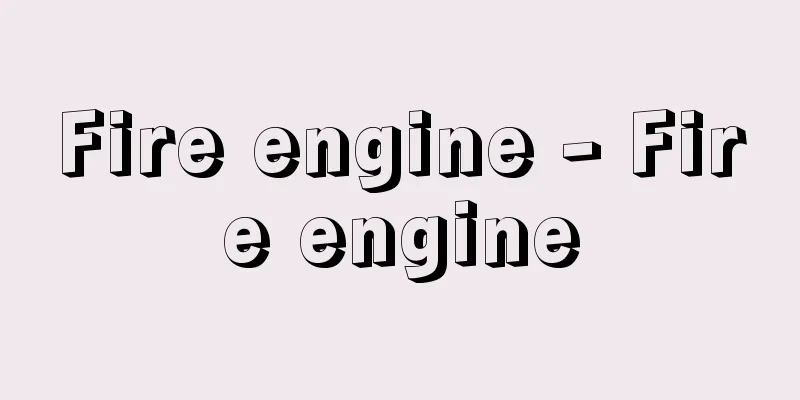Fire engine - Fire engine

|
A steam fire pump is a vehicle used for firefighting, rescue, and other firefighting activities, and is the core of firefighting equipment. In Europe and the United States, the first steam fire pump was manufactured in 1829 by George Braithwaite and John Ericson in London. This was capable of discharging water to a height of about 30 meters with 10 horsepower, several times more powerful than conventional hand pumps, but it was horse-drawn. In 1841, at the request of a fire insurance company in New York, the Englishman Bowlapsey Hodge manufactured a self-powered steam fire pump car. At first glance, this looked like a steam locomotive, and when it arrived at the scene of a fire, it would lift its rear end and the rear wheels would act as a flywheel. At one time, the use of such pump cars was opposed by firefighting officials who feared that firefighters would lose their jobs, and they were discontinued, but later the power of steam fire pump cars was recognized and they became widespread. In 1862, the London Fire Brigade used a steam fire engine that was an improved version of a steam car and could reach a speed of 29 kilometers per hour, and in 1902, the horse-drawn steam pump was improved into a steam fire engine. However, because it was unable to climb steep slopes and took a long time to start, it was reverted to being horse-drawn in 1906. Fire engines were not widely put into practical use until gasoline-powered automobiles were developed, and at first, gasoline-powered automobiles also pulled steam pumps, but in 1908, a fire engine combining a gasoline engine and a fire pump was used for the first time. [Masuo Uotani] In Japan, it was in 1914 (Taisho 3) that Yokohama (made in the UK) and Nagoya (made in Germany) purchased and permanently kept fire pump cars, and gradually the switch was made from steam pumps (imported from the UK in 1870) to cars, with domestic production succeeding in 1915, and by 1920 the Metropolitan Police Department had 25 fire engines and 5 ladder trucks. They then spread throughout the country during the Showa era, and with the rapid development of the automobile industry after World War II, various types of vehicles are currently in use for a variety of purposes. The main ones are as follows: [1] Pump vehicle (2) Fire pump truck with water tank: A fire pump truck equipped with a water tank to enable early firefighting and rescue operations in areas where water facilities for firefighting are underdeveloped. It stops near the scene of a fire and carries out firefighting and rescue operations. (3) Small power pump carrier: A four-wheeled vehicle used to carry and transport fire extinguishing equipment such as small power pumps, suction pipes, and hoses. (4) Articulating Water Tower Vehicle: A two- or three-section boom (main pillar) is attached that can be raised and lowered by a hydraulic cylinder, and water is sprayed from the water cannon at the end to extinguish fires. [2] Ladder truck (2) Fire pump truck with ladder: A fire pump truck with a ladder that can be raised, lowered, extended, and rotated, mounted on its chassis, in order to extinguish fires or rescue lives in high-rise buildings. (3) Fire pump truck with articulating ladder: A fire pump truck with articulating ladder is equipped with a fully rotating turntable at the rear of the vehicle chassis, on top of which is attached a two- or three-section boom that is raised and lowered by a hydraulic cylinder, and is used to extinguish fires or rescue lives in medium- and high-rise buildings. [3] Chemical vehicle (2) Large chemical fire pump trucks: They mix foam concentrate stored in tanks with water from a water source in a certain ratio and pump the mixture to large high-altitude water cannon trucks. They play a central role in the extinguishing system for petrochemical plant fires. (3) Large high-altitude water cannon This is a fire engine for petrochemical plant fires, and is operated in a set with a large chemical fire pump truck and a foam concentrate transport truck (commonly known as a "three-piece set"). This large high-altitude water cannon further pressurizes the foam mixture pumped from the large chemical fire pump truck, and sprays a large amount of foam mixture of more than 3,100 liters per minute on the fire point of an oil tank, etc., for effective fire extinguishing. (4) High-Expansion Vehicle: A special chemical vehicle equipped with a high-expansion device that pumps large amounts of highly expanding foam to simultaneously exhaust smoke and extinguish fires. (5) Foam concentrate transport vehicle: A fire truck for transporting large amounts of foam concentrate. [4] Other (2) Heat-resistant rescue vehicle: A fire engine used to rescue people whose escape routes are blocked by fire or smoke during earthquakes. (3) Water Tanker Truck: A fire engine equipped with a water tank of about 5 to 10 cubic meters on its chassis to secure the water needed for firefighting activities in areas where fire water facilities are not well developed. (4) Meal truck: Supplies hot water, tea, and food to firefighters during long-term disasters. (5) Air Cylinder Supply Vehicle: This vehicle is equipped with spare air cylinders for use by firefighters engaged in life-saving, rescue and firefighting operations in the event of a fire in a smoke-filled building, warehouse, underground shopping mall, etc. (6) Power supply lighting vehicle: Equipped with lighting equipment to assist in firefighting activities at night. (7) Command vehicle: A command vehicle that collects information such as the location of fires and whether there are any people who were unable to escape in order to carry out firefighting activities in an organized manner, and serves as a command center at the disaster site to command and oversee each unit. (8) Ambulance: A vehicle equipped to transport injured or sick people to a hospital in an emergency. [Kubota Kazuhiro] [Reference items] | |©Makoto Takahashi Names of parts of a ladder-equipped fire engine In high places or dangerous places where people cannot approach, a boom (main pole) is extended and water is sprayed from the water cannon at the end to extinguish the fire. ©Shogakukan "> Refraction water tower vehicle They extend ladders to rescue people stranded on higher floors and spray water from high places. ©Shogakukan "> Ladder truck It is equipped with a winch, lighting equipment, and many other rescue equipment. It is primarily used for rescue operations . Rescue vehicle "Famous Places in Japan" (1901, Meiji 34) owned by the National Diet Library Horse-drawn steam pump Source: Shogakukan Encyclopedia Nipponica About Encyclopedia Nipponica Information | Legend |
|
火災の際、消火、救助、その他の消防活動を行う自動車で、消防装備の中心となるもの。欧米では、1829年ロンドンのジョージ・ブライスウェートとジョン・エリクソンによって蒸気消防ポンプが初めて製作された。これは、10馬力で水を約30メートルの高さまで放水でき、従来の手押しポンプに比べて数倍の威力をもつものであったが、馬引きであった。1841年になるとニューヨークで火災保険会社の要請を受け、イギリス人ボウルラプセイ・ホッジが自力で走る蒸気消防ポンプ車を製作した。これは一見蒸気機関車のようなかっこうで、火災現場に到着すると、後端をあげ、後輪ははずみ車としての役目を果たすことになっていた。一時は、このようなポンプ車の使用により、消防手の仕事がなくなることをおそれた消防関係者に反対されて、使用中止になったこともあったが、その後、蒸気消防ポンプ車の威力が認められて普及するに至った。1862年には、ロンドン消防隊で蒸気自動車を改良した時速29キロメートルの蒸気消防自動車を使用、1902年には、これまでの馬引き蒸気ポンプを蒸気消防自動車に改良した。しかし、急坂を登れないことと、始動に時間がかかるため、1906年ふたたび馬引きとなってしまった。消防自動車が広く実用化されたのはガソリン自動車ができてからで、最初はガソリン自動車が蒸気ポンプも牽引(けんいん)する型であったのが、1908年、ガソリン機関と消防ポンプを結合した消防自動車が初めて使用されるようになった。 [魚谷増男] 日本では、1914年(大正3)横浜(イギリス製)、名古屋(ドイツ製)が消防ポンプ自動車を購入、常備配置したのが初めで、しだいに蒸気ポンプ(1870年イギリスから輸入)から自動車に切り替えられ、1915年には国産化に成功、1920年には警視庁に消防車25台、はしご車5台が配備された。その後昭和時代に入り全国に普及、第二次世界大戦後は、自動車産業の急激な発展とともに、現在は各種車両がさまざまな用途に応じて活躍している。おもなものは次のとおりである。 〔1〕ポンプ車 (2)水槽付き消防ポンプ自動車 消防水利の整備が遅れた地域などにおいて一刻も早く初期消火・救助活動が行えるよう、消防ポンプ自動車に水槽を装備したもの。火災現場の近くに停車して、消火・救助活動を行う。 (3)小型動力ポンプ付き積載車 小型動力ポンプ、吸管、ホースなど消火器具を積載し搬送する四輪自動車。 (4)屈折放水塔車 油圧シリンダーにより起伏する2節または3節のブーム(主柱)を取り付け、先端の放水銃から放水消火を行うもの。 〔2〕はしご車 (2)はしご付き消防ポンプ自動車 高層建築物の消火または人命救助に対処するため、起伏、伸縮、旋回のできる構造のはしごを消防ポンプ自動車の車台に積載したもの。 (3)屈折はしご付き消防ポンプ自動車 自動車のシャシー後部に全旋回のターンテーブルを備え、その上に油圧シリンダーにより起伏する2節または3節のブームを取り付け、中・高層建物の消火または人命救助を行うもの。 〔3〕化学車 (2)大型化学消防ポンプ自動車 タンクに蓄えた泡原液と水利から導入した水とを一定の比率で混合し、これを大型高所放水車へ圧送する。石油コンビナート火災の消火システムの中核的な役割を果たしている。 (3)大型高所放水車 石油コンビナート火災用の消防自動車で、大型化学消防ポンプ自動車、泡原液搬送車とセット(通称「3点セット」という)で運用されている。この大型高所放水車は、大型化学消防ポンプ自動車から圧送されてきた泡混合液をさらに加圧し、石油タンク等の火点へ毎分3100リットル以上の大量泡混合液を放射し効果的な消火を図る。 (4)高発泡車 高発泡装置を備えた特殊化学車。大量の高膨張泡を送り込み、排煙と消火を同時に行う。 (5)泡原液搬送車 大量の泡原液を搬送するための消防自動車。 〔4〕その他 (2)耐熱救難車 震災時に、火災や煙により逃げ道をふさがれた人々を救出する消防自動車。 (3)水槽車 消防水利が整備されていない地区における消火活動に必要な水を確保するため、車台に5立方メートルから10立方メートル程度の水槽を装備した消防自動車。 (4)給食車 長時間にわたる災害時に消防隊員に湯茶、食糧の供給を行う。 (5)空気ボンベ補給車 煙の充満するビル、倉庫、地下街などの火災に際し、人命救出、救助、消火に従事する消防隊の呼吸用として用いる空気呼吸器用予備ボンベを積載している。 (6)電源照明車 夜間における消防活動を助けるための照明設備を装備している。 (7)指揮車 消防活動を組織的に展開するために、燃えている箇所、逃げ遅れた人の有無などの情報収集を行い、災害現場での指揮本部として各部隊を指揮統括する車両。 (8)救急車 負傷者・病人などを、緊急に病院に運べるように装備された自動車。 [窪田和弘] [参照項目] | |©高橋 真"> はしご付き消防自動車の各部名称 高所や人が近づけない危険な場所において、ブーム(主柱)を伸ばして先端の放水銃から放水消火を行う©Shogakukan"> 屈折放水塔車 はしごを伸ばし、高層階に取り残された人の救出や高所からの放水などを行う©Shogakukan"> はしご車 ウィンチや照明装置をはじめ、多くの救助資器材を積載。主として人命救助活動を行う©Shogakukan"> 救助工作車 『日本之名勝』(1901年〈明治34〉)国立国会図書館所蔵"> 馬引き蒸気ポンプ 出典 小学館 日本大百科全書(ニッポニカ)日本大百科全書(ニッポニカ)について 情報 | 凡例 |
Recommend
Amazon Lily (English spelling) Amazon-lily
A bulbous plant of the Amaryllidaceae family nativ...
Engishiki
This is one of the Sandai Kakushiki (Three Imperia...
Bendigo - Bendigo (English spelling)
A city in the state of Victoria in the southeast ...
River Bamboo - Kawatake
1. Bamboo growing on the bank of a river. 2 Anothe...
Metallic fibre
Fibers made from metals. Decorative gold and silve...
Medical system - Iryoseido
In a broad sense, it refers to all the social con...
Acetylsalicylic acid
C9H8O4 ( mw180.16) . Also known as aspirin. A drug...
Akegawa-so - Akegawa-no-sho
A manor in Arita County, Kii Province (present-day...
Half-foot sandals - half-foot sandals
...There are also waraji that are a combination o...
Yoshihiro Inayama
Manager. Born in Tokyo. Graduated from the Depart...
Style - yōshiki (English spelling) style English
This word refers to a method of artistic expressi...
Bone shaker
…Around 1861, Pierre Michaux and others from Fran...
Alpers, A. (English spelling) AlpersA
…Other works that include retellings of Maori myt...
Aeroflot (English name)
Russia's national airline. Founded in 1932 as ...
Administrative reorganization - gyoseisei-ri
This refers to personnel reductions of public ser...









